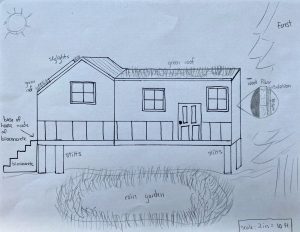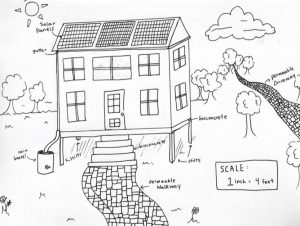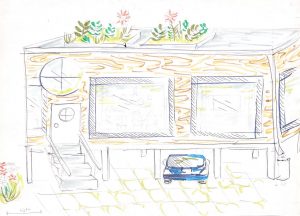By: Lisa Wise, NH Sea Grant Extension
This spring, the Climate in the Classroom program moved up to the high school level for the first time. Barbara Reid, Winnacunnet High School’s chemistry and AP Environmental Science teacher, attended the Teacher Training last summer and wanted to implement the program with her AP class of 16 juniors and seniors.
The project team, including CAW members Amanda Stone (UNH Extension), Lisa Wise (NH Sea Grant Extension), and Abigail Lyon (Piscataqua Region Estuaries Partnership), had several preparatory meetings and made plans for a kickoff presentation followed by additional presentations by Julie LaBranche (Rockingham Planning Commission), Jay Diener (Seabrook-Hamptons Estuary Alliance), and Brian Murphy (local architect with Placework and parent of a student who participated in the Portsmouth Climate in the Classroom program last fall!). While the COVID-19 public health crisis threw us a curveball, we quickly adapted the program to a virtual learning environment to make the program happen.
Groups of students dove into the Tides to Storms vulnerability assessments available for each of the four municipalities that make up the Winnacunnet school district – Hampton, Hampton Falls, North Hampton, and Seabrook. Julie’s presentation shared context about the Tides to Storms assessments and adaptation efforts in local communities, and Jay discussed the work of the Seabrook-Hamptons Estuary Alliance (SHEA) and the Hampton Conservation Commission.
For the culminating project, the groups worked together to design resilient and sustainable buildings, informed by Brian’s presentation about resilient and sustainable design elements, the broader architectural design process, and considerations for both buildings and their environmental context.
The students’ final products included written narratives explaining their design decisions, visual depictions of the buildings, and recorded presentations. One group even used the video game Minecraft to visually ‘build’ their design! Check out their final products below.
| Hampton |
|
Written narrative describing design components |
| Hampton Falls |  |
Presentation slides describing design components |
| North Hampton |  |
Presentation slides describing design components |
| Seabrook |  |
Written narrative describing design components |
Note: These products reflect the ideas and perspectives of the students, and not those of CAW members.
Quotes from the students:
I liked the idea of taking my ideas and thoughts and combining [them] with new knowledge to solve an issue going on in my own town.
It was interesting to see what the biggest concerns were to different towns in terms of sea level rise and storm surge.
The program made me aware of the risks that may endanger our region. It’s good to know there are people monitoring our local environment.
This just made me see Hampton a lot differently. When I’m driving down the beach and seeing the houses built over the marsh it just makes me think of how it will affect Hampton in 50 years.
This program made me think about my own house and the seacoast where I live, and helped me to understand what rising sea levels or storm surge could do to the area. It has definitely made me more aware of how homes can become more resilient to these changes and more sustainable to have less environmental effects.
I’ve been more mindful of my actions and how it effects the world around me.
This was a real eye-opener because I always thought of the seacoast as such a secure and safe place. I know realize that the area could easily be threatened by coastal floods.
I already had a separate career plan, but this is definitely an interesting topic and I will remember what I learned and try to incorporate it into my life in the future.
We missed the direct interaction with the students but were glad we were still able to make the program work! AP Environmental Science teacher, Barbara Reid, helped to make the program as interactive as possible. We recorded the presentations, sent the recordings and relevant resources to Barbara to share with the students, and then she collected the students’ responses and follow-up questions after each session. We even were able to record a Q&A session with Julie and Jay to address the students’ questions after their presentation. It was certainly a different program than in past semesters, but the students were up to the challenge!
Many thanks to the students, to Barbara Reid, and to our fellow presenters – Brian, Julie, and Jay – for participating in this program especially during challenging circumstances.
This program was funded by NOAA’s Office for Coastal Management under the Coastal Zone Management Act in conjunction with the NH Department of Environmental Services Coastal Program.
![]()
Questions? Contact Lisa Wise, Lisa.Wise@unh.edu, 603-862-2356.
